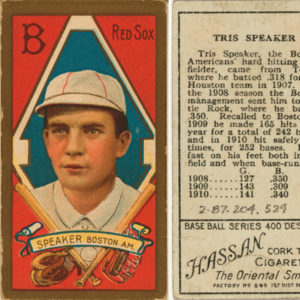calsfoundation@cals.org
Tristram E. Speaker (1888–1958)
Tris Speaker was one of the greatest players in baseball history. Fast, smart, and strong-willed, he reveled in the fierce competition that characterized major league baseball in the early days. Elected in the second class of honorees and formally inducted at the inaugural ceremonies that marked the grand opening of the Baseball Hall of Fame in Cooperstown, New York, in 1939, Speaker was one of the most outstanding performers in baseball, going head to head with greats such as Ty Cobb and Babe Ruth. He was one of only a few players for the Arkansas Travelers who would be elected to the Hall of Fame.
Tristram E. Speaker was born on April 4, 1888, in Hubbard, Texas. His father, Archie Speaker, ran a dry goods store, while his mother, Nancy Jane Speaker, operated a boarding house. After twice breaking his right arm after being thrown by a bucking bronco, Speaker taught himself to throw left-handed, and it was as a lefty that he fashioned his career. He starred in high school in both football and baseball, and he enrolled at Fort Worth Polytechnic Institute (now Texas Wesleyan University) in 1905. There, he pitched for the college team while also playing for the local semi-professional team.
Following his freshman season, he canvassed the local professional teams looking for a tryout and was ultimately signed to a $65-a-month contract by the Cleburne Railroaders of the Texas League. Although his efforts as a pitcher were a disaster, he did a credible job in the outfield, as well as hitting .268 and stealing thirty-three bases in eighty-four games. In 1907, playing for the Houston Buffaloes, he hit a league-leading .314 and stole thirty-six bases.
The Boston Red Sox then bought his contract. The seven-game, end-of-season call-up, however, resulted in a .158 batting average. Unimpressed, the Red Sox did not offer Speaker a contract for 1908. Speaker paid his own way to the Red Sox’s Little Rock (Pulaski County) training camp, subsequently earning a new contract. When the team turned his contract over to the Little Rock Travelers (later the Arkansas Travelers), it retained the option to repurchase the contract if he developed—which he did. On the way to becoming one of only a handful of Travelers players who would be elected to the Hall of Fame, he hit .350 in 127 games in his single season playing for the Arkansas club before he rejoined the Red Sox. Interestingly, that season with the Travelers included the first face-to-face meeting of Speaker and his rival over the next decades, Ty Cobb, when the Tigers played an exhibition game against the Travelers on their way north to start the American League season.
Speaker led the Red Sox to World Series victories in 1912 and 1915 while establishing himself as one of the baseball’s best hitters and fielders. He was known for playing a very shallow center field, which allowed him to turn seeming base hits to the outfield into force outs at second base. At the same time, he could field balls hit over his head, giving him an overall range that was unmatched by his peers. He led the league in outfield assists on multiple occasions while also leading in putouts seven times. He also established himself as an ever-present threat on the base paths.
Although he was popular with the fans, Speaker’s tenure with the Red Sox was not without its challenges. The Red Sox clubhouse was known to be a tense place bedeviled by egos and religious differences. Speaker also clashed with team president Joe Lannin, who traded him to the Cleveland Indians before the 1916 season.
Speaker continued to be one of baseball’s top hitters for the Indians. Speaker took over as the Indians’ playing manager in the middle of the 1919 season and then led them to victory in the 1920 World Series. He remained at the helm until his final season in Cleveland in 1926, compiling a managerial record of 617–520, while hitting just under .350 over the course of his eleven seasons with the Indians. Speaker played the 1927 season with the Washington Senators and the 1928 season with the Philadelphia Athletics, then retiring at the age of forty.
In 1925, he married Mary Frances Cuddihy of Buffalo; the couple had no children. In retirement, they settled in Cleveland, Ohio.
Immediately after his retirement in 1928, he served as the player manager for the Newark Bears of the International League for the 1929 and 1930 seasons, although his playing time, especially during the second season, was minimal. In 1933, he was manager and part owner of the minor league Kansas City Blues of the American Association.
With his induction in 1937, Speaker was one of the first thirteen men selected to the Baseball Hall of Fame. His .345 batting average puts him among the all-time top ten, as do his totals for hits, triples, and runs.
Speaker worked as a sales representative for a Detroit, Michigan, steel company. He also operated Tris Speaker, Inc., a wholesale wine and liquor business. He also stayed involved with baseball as an occasional broadcaster with both the White Sox and Indians, as well as doing some coaching and spring training work with the Indians.
Speaker died on December 8, 1958, while on a fishing trip in Lake Whitney, Texas. He is buried in Fairview Cemetery in Hubbard.
For additional information:
Alexander, Charles C. Spoke: A Biography of Tris Speaker. Dallas, TX: Southern Methodist University Press, 2007
Gay, Timothy. Tris Speaker: The Rough-And-Tumble Life of a Baseball Legend. Lanham, MD: Lyons Press, 2007.
“Tris Speaker.” National Baseball Hall of Fame. http://baseballhall.org/hof/speaker-tris (accessed November 17, 2020).
“Tris Speaker.” Baseball-Reference.com. http://www.baseball-reference.com/players/s/speaktr01.shtml (accessed November 17, 2020).
William H. Pruden III
Ravenscroft School
 Early Twentieth Century, 1901 through 1940
Early Twentieth Century, 1901 through 1940 Recreation and Sports
Recreation and Sports Tris Speaker trading Card
Tris Speaker trading Card  Tris Speaker Trading Card
Tris Speaker Trading Card 




Comments
No comments on this entry yet.